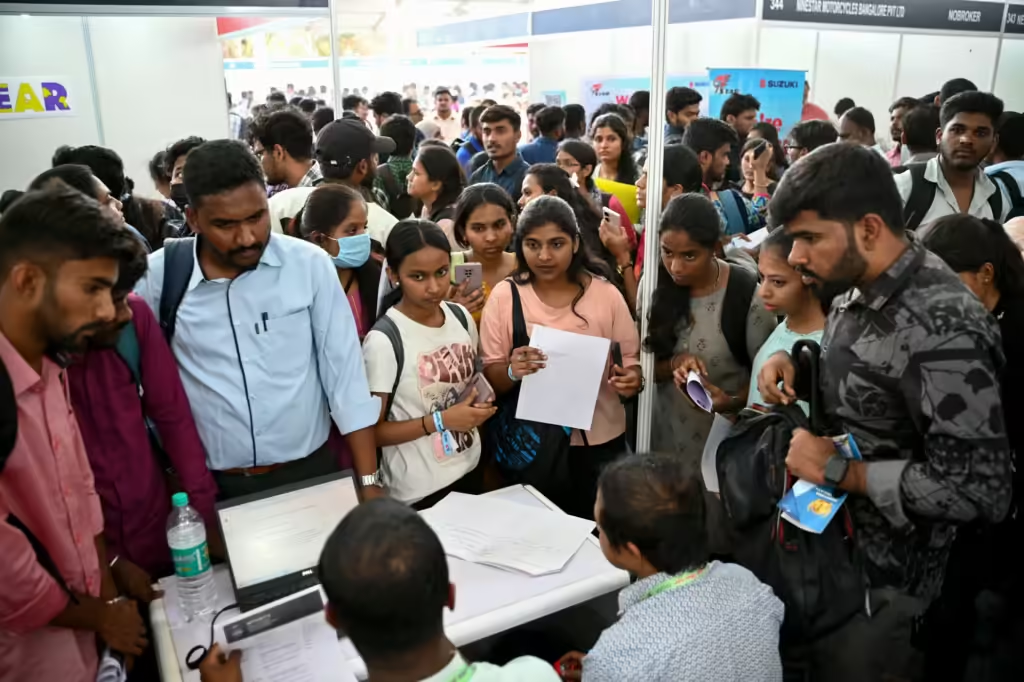Over 60% Young graduates are currently unemployed and every year educational institutions adding to this percentage further raising significant concerns. It’s a difficult time for young people in India, where their dreams are being buried on a daily basis highlighting the inefficiency of the current government.

New Delhi, September 17, 2024: The unemployment rate in India has emerged as a significant issue for both policymakers and economists. Recent data published by the Centre for Monitoring Indian Economy (CMIE) indicates a notable surge in the unemployment rate, which escalated to 9.2% in June 2024, up from 7% in May 2024. This considerable increase underscores the escalating economic difficulties confronting the nation, especially in rural regions where unemployment rose from 6.3% to 9.3%. These statistics reveal profound structural challenges within India’s labor market, underscoring the urgent need for action to address the unemployment crisis.
Unemployment in 2024: Key Concerns
The June 2024 data presents an alarming trend, particularly when analyzed through the lens of gender and regional disparities. Women have been disproportionately affected, with the female unemployment rate reaching a staggering 18.5%, significantly higher than the national average. This persistent gender gap in employment underscores the long-standing barriers that women face in securing sustainable jobs. In contrast, male unemployment remains relatively stable at 7.8%, but still reflects the broader economic difficulties plaguing the nation.
A deeper look at the labor force reveals another concerning trend—the increase in the Labor Participation Rate (LPR), which measures the proportion of the working-age population actively seeking jobs. The LPR climbed to 41.4% in June 2024, up from 39.9% in June 2023. However, this rise in job seekers has not been matched by job creation, indicating a growing mismatch between the demand for jobs and the availability of employment opportunities.
Reasons behind this increase of Unemployment
The rise in unemployment among young graduates can be attributed to several key factors:
- COVID-19 Pandemic: The pandemic led to significant economic disruptions, with job losses and hiring freezes affecting many sectors. According to the International Labour Organization, the pandemic resulted in a 9% decline in global working hours in 2020 compared to the previous year, worsening job prospects for new graduates. Even many businesses got shut down at that time leading to further deepening of the situation.
- Economic Recession: Economic downturns, including the one exacerbated by the pandemic, have led to reduced business activities and layoffs. India’s GDP growth slowed significantly in recent years, with the World Bank forecasting a modest recovery, but not enough to fully absorb the influx of new job seekers.
- Advent of AI and Automation: The rise of AI and automation is reshaping job markets. The World Economic Forum predicts that 85 million jobs could be displaced by automation by 2025, while creating 97 million new roles that may require different skills, contributing to a skills mismatch.
- Skill Mismatch: A report by the Confederation of Indian Industry (CII) highlights that 53% of graduates in India are unemployable due to a mismatch between their skills and industry needs. Many graduates lack the technical and soft skills required by employers.
- Huge Population: India’s vast and growing population intensifies job market competition. With over 1.4 billion people and a young demographic, the job market struggles to keep up with the high number of new graduates entering each year. According to the Centre for Monitoring Indian Economy (CMIE), the youth unemployment rate in India was around 23% in 2023, highlighting the challenge of integrating a large number of graduates into the workforce.
The Reality Behind Job Growth Claims
While the government has claimed that an “unprecedented number” of jobs have been created under the Narendra Modi government, with an average of 10 million jobs per year over the past seven to eight years, many economists have raised concerns about the accuracy of these claims. Government economists have been accused of counting all types of employment, including agricultural work, as “jobs,” a metric that development economists argue is misleading.
Agricultural employment has seen a significant increase, with the number of workers in the sector rising from 200 million to 260 million between 2020 and 2022. However, this increase does not reflect productive employment; rather, it signals a return to low-paying, subsistence-level jobs as more people, particularly those who migrated back to rural areas during the COVID-19 pandemic, are forced to rely on agriculture for survival. This is not a sign of job creation but rather a symptom of “jobless growth,” where employment opportunities are growing, but not in sectors that contribute significantly to economic development.
Structural Change in India’s Employment Landscape
Economic development is typically characterized by a shift away from agriculture towards industry and services, sectors that are more productive and contribute more to overall GDP. India had been on this path for many years, with non-farm jobs growing at a rate of 7.5 million per year between 2004 and 2012, during which the country’s GDP growth rate was a remarkable 7.7%. However, this trend has since reversed.
The number of non-farm jobs created fell sharply in 2019, down to 2.9 million per year, while better-educated youth continued to enter the labor market in larger numbers. This mismatch between the supply of skilled labor and the availability of jobs has led to a steep rise in youth unemployment, which increased from 6% in 2012 to 17.8% in 2018.
One of the more troubling aspects of India’s unemployment crisis is the assertion by some government economists that youth unemployment is primarily “frictional,” meaning that it is temporary and mainly affects people aged 15-29. However, this view ignores the long-term consequences of prolonged unemployment, particularly for young people who are unable to find meaningful work during the early years of their careers. Even if they find employment after the age of 30, it is often in the informal sector, where job security and wages are low.
Gender Disparities in the Job Market
The female labor force participation rate (FLPR) has seen a notable increase in recent years, rising from 24.5% in 2019 to 37.0% in 2023. However, much of this increase has been in the agricultural sector, where many women are forced to work in unpaid family jobs due to the lack of other opportunities. Between 2017 and 2023, the number of women engaged in unpaid family work in agriculture rose from 28.3 million to 58.2 million, while the number of women working on their own farms increased from 9.2 million to 29.2 million. This rise in employment is driven by economic distress, not by the creation of quality jobs, and underscores the need for better employment opportunities for women.
Manufacturing and Non-Farm Jobs: A Stalled Sector
Manufacturing, a key driver of employment in developing economies, has not seen the growth needed to absorb the increasing number of job seekers in India. Between 2011 and 2018, manufacturing employment actually fell from 60 million to 55 million. This decline is particularly concerning given that manufacturing had been a major contributor to employment during the 2004-2012 period, when the sector’s share of employment grew from 10.5% to 12.8%.
The decline in manufacturing jobs has been accompanied by a decrease in the sector’s contribution to India’s Gross Value Added (GVA), which fell from 17% in 2016 to 13% in 2022. The COVID-19 pandemic exacerbated this trend, as millions of workers were forced to return to agriculture between 2020 and 2023.
Wage Stagnation: A Symptom of Economic Distress
In India, real wages have stagnated across all sectors, including agriculture, construction and manufacturing. This wage stagnation is a persistent problem, even as the overall unemployment rate fell between 2018 and 2022. Government data shows that the income of 80% of Indian workers, especially those in the regular and autonomous categories, have been stagnant for the last five years.
The Government’s Response: Skill Development Initiatives
Recognizing the severity of unemployment, the government has introduced various measures to enhance the job prospects of the young Indian workforce. One such initiative is a proposal in Budget 2024 to provide Rs 5,000 per month to one million graduates for internships in 500 top companies, with training costs covered by corporate social responsibility (CSR) funds.
In addition, a new skilling scheme sponsored by the central government will be launched. This program aims to skill 20 lakh youngsters in the upcoming five years and modernize 1,000 industrial training institutes through a hub-and-spoke model.
Even, the skill loan model will be revised to provide loans up to ₹7.5 lakh, guaranteed by the government fund, benefitting 25,000 students every year. Those who are not eligible for the current schemes will receive financial assistance for loans up to 10 lakh, along with e-vouchers for 1 lakh students per year with a covered annual interest rate of 3%. The objective of this program is to enhance the potential of young people in obtaining jobs by improving their skills, while also addressing the disparity between the abilities of graduates and the demands on the labor market.
The budget also supports MSMEs with a new self-financing guarantee fund that provides up to Rs 100 crore per applicant. Mudra loan limits will be increased to ₹ 20 lakh for successful borrowers and financial assistance will be provided for food irradiation units and quality testing laboratories.
However, despite these efforts, significant challenges remain. The Ministry of Skills Development’s 2022-23 report found that only 51% of Indian graduates are employable, highlighting the need for more robust training programs tailored to industry demands.
Conclusion
The unemployment crisis in India is a multifaceted problem that requires urgent attention. Recent data shows a growing mismatch between job seekers and job opportunities, particularly in non-agricultural sectors such as manufacturing and services. Gender inequalities, youth unemployment and wage stagnation also complicate the situation.
While the government has made progress in addressing these issues through skill development initiatives, more comprehensive policies are needed to ensure that India’s workforce can find meaningful and sustainable employment. As India moves towards becoming a global economic powerhouse, addressing the unemployment crisis will be critical to ensuring long-term economic growth and social stability.

